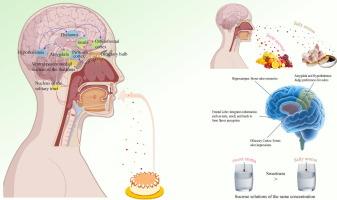Olfactory–gustatory cross-modal integration: mechanisms of aroma-induced sweetness enhancement, sensory evaluation methodologies, neuroimaging evidence and advances in influencing factors
IF 13
1区 综合性期刊
Q1 MULTIDISCIPLINARY SCIENCES
引用次数: 0
Abstract
Background
Excessive sugar intake induces health issues such as excess energy, obesity and cardiovascular diseases. Reducing sugar consumption has become a global consensus; however, achieving this without compromising flavour perception remains a major challenge. Previous studies have highlighted the potential risks associated with non-nutritive sweeteners, and novel measures for sugar reduction, such as modifying sweetener ratios and enzymatic conversion, are limited in scope. In-depth studies have revealed that aroma-induced sweetness enhancement is a promising alternative for reducing sugar consumption without compromising perceived sweetness, enabling a healthy way of enjoying sweet flavoursAim of review
By systematically sorting out current knowledge on the mechanism of action, evaluation approaches, and influencing factors of aroma-induced sweetness enhancement, and revealing the cross-modal interaction mechanism between aroma and taste, this study aims to provide a theoretical framework for advancing research on multisensory flavor perception. Furthermore, it underscores the potential of the interdisciplinary integration of neurosensory science and food science to inform the design of flavor optimization strategies for low-sugar products, thereby contributing to healthier dietary solutions for targeted populations.Key scientific concepts of review
Herein, the physiological basis of taste and smell and their perceptual pathways are systematically reviewed, and the neural and psychological factors of olfactory–gustatory synergy are investigated. In addition, this review summarises the sensory evaluation methods and neuroimaging techniques to assess the sweetening effects of aroma. Moreover, it discusses various factors influencing aroma-induced sweetness enhancement, including the physical properties of food, eating environment, individual differences in consumers and oral processing. Aroma-based sweetening has great potential for sugar reduction without compromising sweetness, and future in-depth research requires interdisciplinary cooperation covering multiple dimensions such as molecular mechanisms, personalisation techniques, ingredient screening, stability optimisation, evaluation method innovation and health regulation adaptation.

嗅觉-味觉跨模态整合:香气诱导的甜味增强机制,感官评价方法,神经影像学证据和影响因素的进展
摄入过多的糖会导致能量过剩、肥胖和心血管疾病等健康问题。减少糖的摄入已成为全球共识;然而,在不影响风味感知的情况下实现这一目标仍然是一个重大挑战。先前的研究强调了与非营养性甜味剂相关的潜在风险,而减少糖的新措施,如改变甜味剂比例和酶转化,在范围上是有限的。深入研究表明,香气增强是一种很有前景的替代方法,可以在不影响感知甜度的情况下减少糖的消耗,实现健康的甜味享受方式。综述目的通过系统梳理目前关于香气增强的作用机制、评价方法和影响因素的知识,揭示香气与味觉之间的跨模态相互作用机制。本研究旨在为推进多感官风味感知的研究提供理论框架。此外,它强调了神经感觉科学和食品科学跨学科整合的潜力,为低糖产品的风味优化策略设计提供信息,从而为目标人群提供更健康的饮食解决方案。其中,对味觉和嗅觉的生理基础及其感知途径进行了系统的综述,并对嗅觉-味觉协同作用的神经和心理因素进行了研究。此外,本文还对评价香气增甜作用的感官评价方法和神经影像学技术进行了综述。此外,还讨论了影响香气增强甜味的各种因素,包括食品的物理性质、食用环境、消费者的个体差异和口腔加工。芳香甜味剂在不影响甜度的前提下具有巨大的减糖潜力,未来的深入研究需要从分子机制、个性化技术、成分筛选、稳定性优化、评价方法创新、健康监管适应等多个维度进行跨学科合作。
本文章由计算机程序翻译,如有差异,请以英文原文为准。
求助全文
约1分钟内获得全文
求助全文
来源期刊

Journal of Advanced Research
Multidisciplinary-Multidisciplinary
CiteScore
21.60
自引率
0.90%
发文量
280
审稿时长
12 weeks
期刊介绍:
Journal of Advanced Research (J. Adv. Res.) is an applied/natural sciences, peer-reviewed journal that focuses on interdisciplinary research. The journal aims to contribute to applied research and knowledge worldwide through the publication of original and high-quality research articles in the fields of Medicine, Pharmaceutical Sciences, Dentistry, Physical Therapy, Veterinary Medicine, and Basic and Biological Sciences.
The following abstracting and indexing services cover the Journal of Advanced Research: PubMed/Medline, Essential Science Indicators, Web of Science, Scopus, PubMed Central, PubMed, Science Citation Index Expanded, Directory of Open Access Journals (DOAJ), and INSPEC.
 求助内容:
求助内容: 应助结果提醒方式:
应助结果提醒方式:


